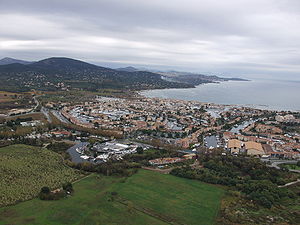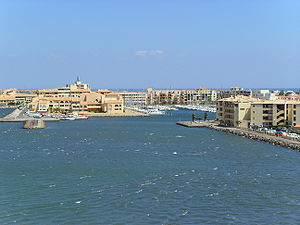- Tourist landscape
-
A tourist landscape can be described as constructed through a variety of symbolic and material transformations of an original physical and/or socioeconomic landscape in order to serve the interests of tourists and the tourist industry.
Since the early days of tourism, landscape has played an important role in the decision making for holiday destinations. In trying to escape from an ordinary taken-for-granted-world, people of all periods have looked to far-away landscapes in order to re-create.
Landscapes are no longer exclusively shaped by the productive claims of agricultural interests. More and more, its form is a reflection of the consumer demand and recreation, tourism and even nature conservation combine to model the ‘new aesthetics of nature’ (Wilson, 1992). The media confronts people with an ever more varied palette of images of their surroundings. Commercial broadcast by the World Wide Fund for Nature, vacation folders displayed by the tour operators and tourist boards, and the travel reports published in glossy magazines determine to a large degree how the tourist landscape should look. The most influential parties come from the new middle class, consisting of individuals and groups who are concentrated in professions like the media and fashion, education, and the arts and sciences. In this context the tourism industry constructs the rural idyll, an understanding of the countryside based partly on reality, but largely on nostalgia and romance:
- It is sustained and developed by media images and popular imagination. It portrays a world of unchanging values, traditional and community living which some people feel with regret has been lost forever from their own lives. The heritage industry has developed to meet such expectations. It packages and presents aspect of the heritage in ways which broadly sustain the illusion of unchanging values(The National Trust, 1995, 11).
However by this aesthetic appropriation the landscape has become an assemblage of beautiful forms that ignores the basically vital aspects.
A related problem is that tourism landscapes are frequently subject to the characteristic problems of common pool resources - a tendency toward overuse and a lack of incentive for individuals to invest in maintaining or improving the resource (Healy, 1994). Scenic landscapes are often the result of active (traditional) land management. The fading away of the pastoral economy in Alpine regions or the traditional orchard economy in parts of the Mediterranean threatens the characteristic scenery of old cultural landscapes.
Contents
The Mediterranean landscape
To the peoples of Northern Europe the Mediterranean landscape represented an ideal that has to be admired, sketched, painted and visited. From the beginning of the nineteenth century on the Mediterranean landscape functioned as a promotional objective of the nascent tourist industry. The presence of celebrities and highly effective publicity campaigns in combination with the work of many artists turned the regional geographical landscape into a tourist landscape, a dream space for the twentieth century. Luginbühl (1992) suggests that tourist publicity posters that appeared toward the end of the nineteenth century were used to represent the Mediterranean landscape and to reinforce the selective view of that landscape held by an elite stratum of society. Characteristic of these posters is the emphasis on the ‘exotic’ in the Mediterranean landscape. Plant life especially is used to symbolise the ideal tourist scenery whilst constructing a landscape that retreats from reality:
- The Mediterranean landscape is replaced with a landscape in which the only thing that is Mediterranean is the stuff of the tourist promotion: a beach, a palm-tree, and a couple browning their skin in the sun or letting their hair blow in the wind. The Mediterranean landscape no longer exists, because it has been made palatable to all(Luginbühl, 1992, 227).
The pilgrim’s way to Santiago de Compostela
Another example of impressive transformations is the pilgrim’s way to Santiago de Compostela, one of the most famous long distance routes in Europe. The different itineraries formed a kind of religious network in the past. Now the EC has discovered the importance of this route and has themed it as the cultural route of Europe. Subsidised by EC funds a considerable part of the authentic pilgrim’s way in the Tiere de Campos in Northwestern Spain has been completely transformed into a comfortable tracking road. Trees have been planted on every ten meters, supplied with water by a smart irrigation system. After every kilometer the tired modern pilgrim can take some rest. Nobody has to be afraid in getting lost in this area because even the smallest village is signposted by an impressive stone. So the suffering of the former pilgrims has become unreachable for the modern ones. They are degraded to ordinary tourists. And the landscape? It is rationalised and it seems to be a question of time before the first multinational company establishes a chain of fast-food outlets along the route.
The Alpine landscape
The Mediterranean landscape is not the only example of how tourism contributes to the construction of model tourist landscapes. The Alpine regions too represent a model tourist landscape that combines ideas on both the sublime and the savage. The Alps were regarded as a wilderness and the habitat of a society free and archaic in its direct contact with nature.
- The characteristic environmental variety of the Alps offered concrete manifestations of idealized landscape models: the mountains were also an imaginary-symbolic space to which ideal properties could be attributed, such as those imposed by nature on its inhabitants to make them rough, but, also free and ‘natural’ Scaramellini, 1996, 53).
Ehrentraut (1996) remarked on the continuing attractive power of stereotypical alpine landscapes to contemporary tourists despite the rapid transformations of the traditional rural landscape and its vernacular architecture. Open air museums reinforce these existing meanings and contribute to the persistence of an idea of rurality on the symbolic level:
- Popularized and commodified by the travel industry, these lieux de mémoire thus become stations of the secular pilgrimage that tourists make through the cultural landscape of modern society in search of the authenticated experiences central to their collective identities(Ehrentraut, 1996, 22).
Holiday villages
In the Netherlands the ideal of an ‘exotic holiday-destination’ is without any doubt strongly influenced by the image of the Mediterranean landscape. It is incorporated in the designing of holiday villages and the enormous increase of these facilities in the last decades has transformed parts of the Netherlands into real leisure landscapes. We see the encroachment of brick and concrete over the landscape in favourable tourist regions such as the coastal zones and the Veluwe region. The high quality holiday villages sell a subtropical illusion in a country with a temperate maritime climate. The Mediterranean concept became predominant in the design, the range of services and the names of resorts such as Porte Zelande or Porte Grève in the province of Zeeland. The inspiration for the design of Porte Zelande on the Brouwersdam was drawn from Port Grimaud in southern France. Port Grimaud can be considered as one of the most well-known examples of a radical landscape transformation. In 1962, the architect Spoerry acquired a stretch of marshy land near Saint Tropez. He transformed this area to the ultimate example of future leisure ports.
Beach parks and résidences have become popular and change the landscape dramatically in certain regions. Another example can be find along the Languedoc-Roussillon coast in southern France in the huge leisure based urbanisation around Port Leucate.
In order to differentiate themselves to win the favour of clients, resorts point to the attractive environment in the form of landscape and culture. In addition to some holyday villages, golf links are also making inroads on the countryside. Not surprisingly, the holyday villages developed most recently tend to be in the immediate vicinity of nature preserves or the seacoast. The use that people make of the surroundings of a holiday village is becoming more and more intensive, changing the appearance of the landscape into a tourist landscape.
References
- Clark, G. et al. (1994), Leisure Landscapes. Leisure, Culture and the English Countryside: Challenges and Conflicts, CPRE Publications, London
- Dietvorst, Adri en Jan Philipsen (1996), The landscape of leisure, Geografie, 5(5): 28-31
- Dietvorst, Adri (1998), Tourist landscapes: Accelerating transformations, in: Sheila Scraton (ed.), Leisure, Time and Space: Meanings and Values in People’s Lives, LSA Publication, no. 57, Brighton, 13-24
- Dietvorst, A.G.J. (2001), Het toeristisch landschap tussen illusie en werkelijkheid, Afscheidsrede Universiteit Wageningen
- Ehrentraut, Adolf (1996), Globalization and the representation of rurality: Alpine Open-air museums in advanced industrial societies, Sociologia Ruralis, 36(1): 4-26
- Healy, Robert (1994), The ‘common pool’ problem in tourism landscapes, Annals of Tourism Research, 21(3): 596-611
- Luginbühl, Yves (1992) Apollonian and Dionysian, in: Luginbühl, Yves (ed), Mediterranean Landscape, Sevilla, Cartuja de Santa Maria de las Cuevas, June-October 1992, Electa, Milan, 24-31
- Luginbühl, Yves (1992) The Mediterranean landscape and its value in tourist publicity, in: Luginbühl, Yves (ed), Mediterranean Landscape, Sevilla, Cartuja de Santa Maria de las Cuevas, June-October 1992, Electa, Milan, 224-227
- The National Trust (1995), Linking People & Place, A consultation report, The National Trust, Cirencester
- Scaramellini, G. (1996), The picturesque and the sublime in nature and landscape: Writing and iconography in the romantic voyaging in the Alps, GeoJournal, 38(1): 49-57
- Wilson, W. (1992), The culture of nature. North American Landscape from Disney to the Exxon Valdez, Blackwell, Oxford
Categories:
Wikimedia Foundation. 2010.


